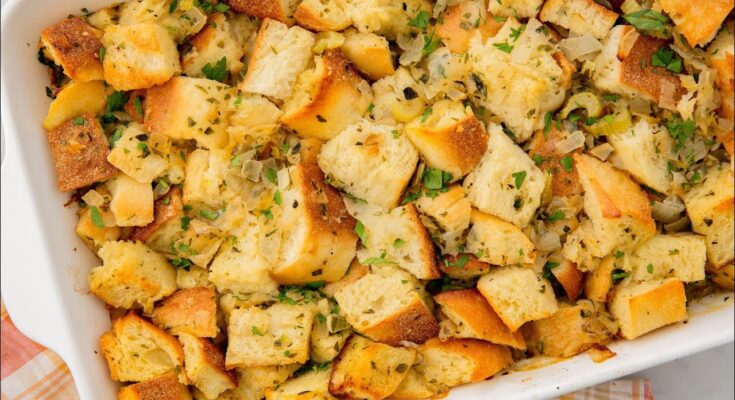Turkey Dressing Recipe: If there’s one side dish that never fails to make an appearance at the Thanksgiving table, it’s turkey dressing. It’s warm, savory, rich, and loaded with all the comforting flavors of the season. Whether you’re new to making it or just looking to perfect your method, this guide will walk you through everything step by step.
But before diving into the cooking process, let’s clear up one common confusion: the difference between dressing and stuffing. Although they often have similar ingredients, stuffing is typically cooked inside the turkey, while dressing is baked separately in a dish. That one little distinction can change the flavor and texture quite a bit. Dressing tends to have a crispier top and a less moist consistency compared to stuffing, making it a favorite for those who love that golden crust.
Whether you call it dressing or stuffing (depending on where you’re from), the result is always delicious if done right. This guide aims to make sure yours turns out perfect every single time.
Ingredients You’ll Need
Creating a delicious turkey dressing starts with the right ingredients. Below is a breakdown of what you need, but remember—this is one of those dishes where you can really make it your own by adjusting seasonings or adding in extras based on what you love.
Main Ingredients:
- Day-old bread cubes (white, sourdough, or cornbread)
- Onions, finely chopped
- Celery stalks, diced
- Butter (unsalted is best)
- Chicken or turkey broth
- Eggs
- Fresh herbs (sage, parsley, thyme)
- Salt and pepper to taste
These basics form the soul of the dish—bread for texture, veggies for a little crunch and aromatics, broth for moisture, and herbs for that unmistakable Thanksgiving flavor.
Optional Add-ins for Extra Flavor:
- Cooked sausage
- Chopped apples or cranberries
- Pecans or walnuts
- Mushrooms
- Garlic
Adding any of these can elevate your dressing from traditional to unforgettable. Try sausage for a heartier flavor, or toss in apples for a sweet twist.
Tools and Equipment Required
Making turkey dressing doesn’t require a high-end kitchen or fancy gadgets, but a few reliable tools will definitely make your job easier.
Must-Have Kitchen Tools:
- Large mixing bowl: To combine all the ingredients evenly.
- Sauté pan or skillet: For cooking your vegetables and sausage if using.
- Baking dish: A 9×13-inch dish works perfectly for most standard recipes.
- Whisk and spoon: For mixing ingredients and blending eggs into the broth.
Nice-to-Have Extras:
- Food processor: For quick veggie chopping.
- Measuring cups and spoons: To keep ingredient amounts consistent.
- Basting brush: If you want to brush butter over the top before baking.
Having the right tools doesn’t just make things easier—it also helps you achieve the best results by ensuring everything’s well-mixed and cooked properly.
Preparing Your Ingredients
A great turkey dressing starts well before it hits the oven. Prepping each ingredient properly is key to achieving the ideal balance of flavors and textures.
Prepping the Bread Base
The bread is the backbone of your dressing. You’ll want it to be slightly stale so it can soak up the liquids without becoming mushy. If you don’t have day-old bread, cube your fresh bread and toast it in the oven at 300°F (150°C) for about 15-20 minutes until dry but not browned.
Cube the bread into uniform pieces—around ½ inch to 1 inch is a good size. Too small and it turns to mush; too large and it won’t cook through evenly.
Chopping Vegetables and Herbs
Dice the onions and celery into small, uniform pieces so they cook evenly. Use fresh herbs if possible—they provide a vibrant, aromatic touch that dried herbs just can’t match. If you only have dried, remember the rule: use one-third the amount of dried herbs compared to fresh.
For an added layer of flavor, consider lightly sautéing the herbs with the veggies before adding them to the bread mixture. It releases their essential oils and deepens the flavor.
Step-by-Step Instructions
Now that everything is prepped, it’s time to bring your turkey dressing to life. These steps are straightforward and beginner-friendly, so whether it’s your first time or your fiftieth, you’ll be in good hands.
Step 1: Sautéing Aromatics
Start by melting butter in a large skillet over medium heat. Add your chopped onions and celery. Cook for about 8-10 minutes, stirring frequently, until the vegetables are soft and translucent. If you’re adding garlic, toss it in for the last 2 minutes of cooking. At this point, your kitchen will start to smell like Thanksgiving magic.
Want to kick it up a notch? Add crumbled cooked sausage or mushrooms to the pan. Let everything cook together until browned and fragrant.
Step 2: Mixing the Dressing Base
In your large mixing bowl, combine the sautéed vegetables with the dried bread cubes. Mix gently so you don’t break up the bread too much.
Next, whisk your eggs with the broth and pour it over the bread mixture. Toss everything to coat. The bread should be moist but not soggy—kind of like a well-wrung sponge. If it seems dry, add a little more broth.
Step 3: Adding Liquids and Seasonings
Once you’ve moistened your bread mixture with broth and eggs, it’s time to season. This is where your dressing develops its character. Start by adding salt and pepper to taste—go light if your broth is salted. Then, fold in your chopped fresh herbs: sage, thyme, parsley, and even a bit of rosemary if you like that woody note.
If you’re adding extras like cranberries, apples, or sausage, now’s the time to mix those in as well. The key is to gently fold everything together to keep the bread’s texture intact. Overmixing will turn it into mush, so be gentle. Let the mixture sit for 5–10 minutes to absorb the flavors before baking.
Step 4: Baking to Perfection
Preheat your oven to 350°F (175°C). Lightly grease a 9×13-inch baking dish with butter or nonstick spray. Spoon your dressing mixture into the dish, spreading it evenly but without pressing it down too firmly—you want it airy, not packed.
For that golden, crispy top, dot a few pats of butter across the surface before it goes in the oven. Bake uncovered for 40–50 minutes, or until the top is browned and the middle is hot and cooked through. If you like it super crispy, broil the top for the last 3–5 minutes—just keep a close eye so it doesn’t burn.
Let it rest for 10–15 minutes after baking. This helps it set and makes it easier to slice and serve.
Tips for the Best Turkey Dressing
Achieving that “just right” turkey dressing comes down to a few pro tips. First, make sure your bread is properly dried or toasted. If it’s too fresh, the dressing turns soggy; if it’s too hard, it won’t absorb flavors well. Strike a balance by prepping your bread a day or two ahead.
Moisture Balance
This is the secret sauce to great dressing. Too dry, and you’ll have a crouton casserole. Too wet, and it’s just mush. The trick? Gradually add broth until the bread is moist but holds its shape. Always reserve a little broth to adjust the texture just before baking.
Flavor Enhancers
Don’t be afraid to season boldly. Herbs should be fresh, veggies sautéed until sweet, and butter generous. A splash of white wine or a pinch of poultry seasoning can take your dish to the next level. Want umami? Add a touch of soy sauce or grated Parmesan cheese—your guests will ask for the recipe.
Common Mistakes to Avoid
Even experienced cooks can slip up when it comes to dressing. Here are a few common pitfalls—and how to dodge them:
Overmixing the Ingredients
Once the bread soaks up liquid, it’s very delicate. Stirring too aggressively will break it down into a mushy mess. Use a large spoon or your hands to gently fold everything together. Think of it like handling a delicate soufflé: soft, minimal, and respectful.
Undercooking or Overcooking
Timing is everything. Undercook it, and the center will be wet and gummy. Overcook it, and the edges will dry out like toast. Stick to the recommended bake time and check the center with a knife—if it comes out clean and hot, you’re golden.
Also, resist the temptation to cover it with foil the entire time unless you prefer it super soft. For a perfect balance, cover it for the first 20 minutes and then uncover to crisp up the top.
Variations of Turkey Dressing
The beauty of this recipe is how flexible it is. Let’s explore some of the most popular and flavorful twists on classic turkey dressing.
Southern Cornbread Dressing
In the South, dressing usually means cornbread dressing. Replace your white bread cubes with crumbled cornbread, add sautéed onions, celery, and sage, and pour in a rich broth made from turkey drippings. This version is more crumbly, buttery, and packed with soul food flavor.
Sausage and Apple Dressing
Sweet meets savory in this combo. Use a mild or spicy Italian sausage, crumble and brown it before mixing. Add peeled, diced apples for contrast. The meat adds depth, and the apples bring a sweet brightness that pairs beautifully with roasted turkey.
Vegetarian Version
Skip the meat and broth made from animals—use veggie broth and add hearty ingredients like mushrooms, caramelized onions, and toasted nuts for texture and richness. Want to give it more body? Add mashed sweet potatoes or squash for a velvety, plant-based twist.
Serving Suggestions
Turkey dressing is a show-stopper on its own, but it truly shines when served alongside the right dishes.
What to Pair With Turkey Dressing
- Roast Turkey (obviously)
- Cranberry Sauce – The tangy sweetness balances the richness.
- Mashed Potatoes – Creamy, fluffy, and the perfect sidekick.
- Green Bean Casserole – For a bit of crunch and contrast.
- Gravy – Pour it over your dressing for that extra wow.
Garnishing Ideas
Want to impress your guests? Try garnishing your turkey dressing with:
- Chopped fresh parsley or thyme
- Toasted pecans
- A drizzle of browned butter
- Crispy fried onions on top for extra crunch
These simple touches turn a humble dish into something dinner-party worthy.
Storage and Reheating Tips
Turkey dressing is one of those dishes that actually gets better the next day—if you store it correctly. Whether you have leftovers or you’re prepping ahead, knowing how to store and reheat it properly will keep your dressing tasting fresh and delicious.
How to Store Leftovers
Let the dressing cool completely before storing. Once it’s no longer hot, spoon it into airtight containers or tightly cover the baking dish with aluminum foil or plastic wrap. Place it in the refrigerator and use within 3–4 days for best flavor and texture.
If you plan to keep it longer, freezing is a great option. Transfer cooled dressing to freezer-safe containers or resealable bags. Press out excess air and label with the date. It will stay fresh for up to 3 months.
Reheating Without Drying Out
The key to reheating dressing is moisture. Add a splash of broth or water before reheating to help it regain its texture. If reheating a single serving, microwave it on medium heat, covered with a damp paper towel. For larger portions, bake in the oven at 325°F (160°C), covered, for 15–20 minutes, or until heated through.
Avoid high heat or long cooking times when reheating, as they can dry it out. A bit of butter on top before reheating can also restore that rich, savory flavor.
Make-Ahead Instructions
Making dressing from scratch during the holidays can feel overwhelming, especially when you’re juggling turkey, sides, and desserts. Thankfully, dressing is very forgiving and actually benefits from being made ahead of time.
Prepping Ahead for Holidays
You can prep all your ingredients 1–2 days in advance:
- Cube and dry the bread
- Chop vegetables and herbs
- Cook and crumble sausage (if using)
- Mix the wet ingredients (broth, eggs, seasoning)
On the day of serving, just combine everything and bake. Or, go one step further—assemble the full dish, cover, and refrigerate overnight. Bake fresh the next day for a stress-free experience.
Freezing Tips
Want to get even further ahead? Assemble the dressing, place it in a freezer-safe dish, and wrap tightly. Freeze for up to three months. When ready to use, thaw overnight in the refrigerator and bake as usual, adding 10–15 minutes to the cooking time.
This make-ahead approach frees up your oven and your time, giving you more moments to spend with family instead of being stuck in the kitchen.
Nutritional Information
While turkey dressing isn’t exactly health food, you can make some smart tweaks to suit your dietary needs without sacrificing flavor.
Calorie Count (Per Serving Estimate)
A typical serving (around 1 cup) contains:
- Calories: 220–300
- Carbs: 25–35g
- Protein: 6–10g
- Fat: 10–15g
These numbers can vary based on your ingredients, especially if you include sausage, nuts, or butter-heavy components.
Healthy Substitutions
- Whole grain or low-carb bread for a fiber boost
- Egg substitutes or flax eggs for fewer calories and cholesterol
- Low-sodium broth to control salt intake
- Plant-based butter or olive oil for heart health
- Add more vegetables like carrots, spinach, or mushrooms to bulk it up without more calories
You don’t need to compromise on taste to make your dressing a little healthier. Just a few swaps can make a big difference.
FAQs about Turkey Dressing Recipe
1. Can I Make It Without Eggs?
Yes, you can! Eggs act as a binder and add richness, but they aren’t essential. You can skip them altogether or use egg replacers like flaxseed meal (1 tbsp flax + 3 tbsp water = 1 egg) or a store-bought vegan substitute.
2. How Long Can I Store Dressing?
Refrigerated, dressing lasts about 3–4 days. Frozen, it stays good for up to 3 months. Always store it in airtight containers and reheat thoroughly before serving.
3. Can I Use Fresh Bread Instead of Day-Old?
Fresh bread has too much moisture and tends to become mushy. If you only have fresh bread, cut it into cubes and toast it in a 300°F oven for 15–20 minutes until dry and slightly crisp.
4. Is It Better to Bake Covered or Uncovered?
Both! Start covered to retain moisture, then uncover during the last 15–20 minutes to brown the top. This method gives you the best of both worlds—tender inside, crispy on top.
5. What If My Dressing Is Too Dry or Too Wet?
If it’s too dry, add warm broth and mix gently. If it’s too wet, bake it a little longer uncovered to evaporate excess moisture. Always adjust gradually to avoid overcorrecting.
Conclusion
Turkey dressing is more than just a side dish—it’s a holiday tradition, a comfort food classic, and a way to bring warmth and love to your table. Whether you’re following a cherished family recipe or experimenting with new flavors, the beauty of dressing lies in its versatility.
By following this step-by-step guide, you’ll master not just the method but also the art of creating a dish that tastes like home. From choosing the right bread to nailing the perfect bake, you’re now ready to serve a dressing that’s moist, flavorful, and full of festive goodness.
So this holiday season, skip the stress and trust this tried-and-true recipe. Your guests will be back for seconds—and probably ask for leftovers, too.


